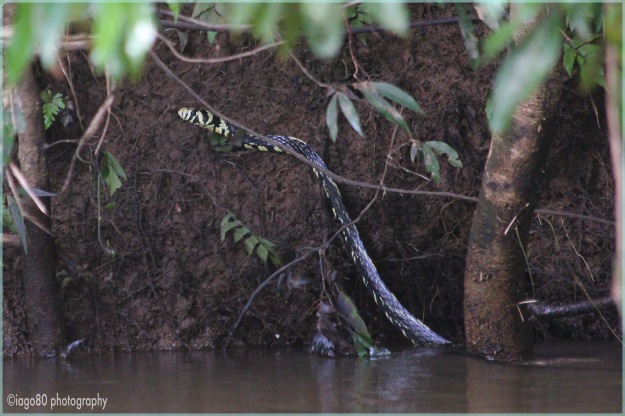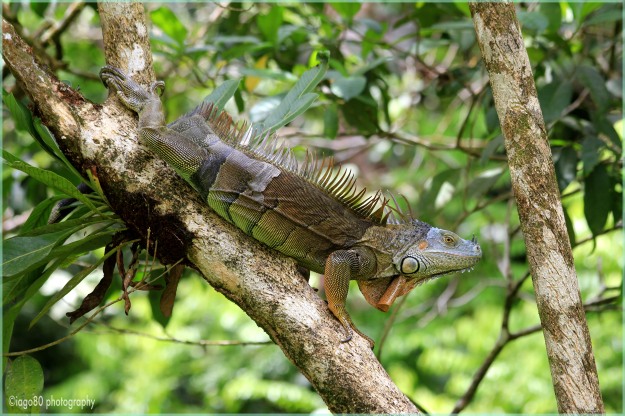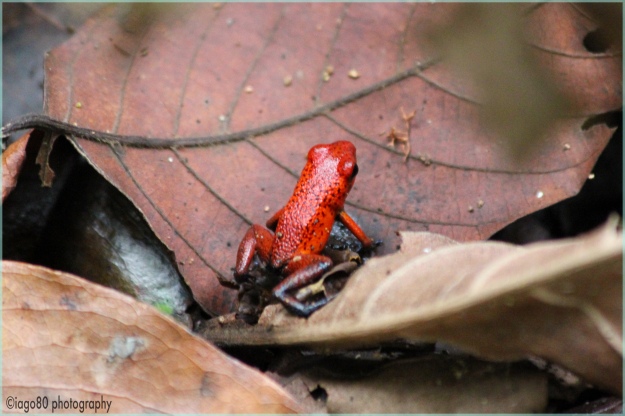We have already explored how Costa Rica is a birding paradise. However, it is much more than that. Costa Rica is believed to contain the greatest density of species in the world. There are a couple of good reasons why this should be so…
Forming the Isthmus
Costa Rica is geologically young. Only a few million years ago, the North and South American continents were separate. The Pacific and Atlantic oceans freely intermingled in an increasingly narrowing gap. As the continental plates pushed together, the pressure caused fissures and volcanos to form; breaking up out of the sea. Sediment gradually built up around these volcanic islands and around 3 million years ago, the oceans were separated and the Central American Isthmus was formed.
The area remains volcanically active, and we were lucky enough to see a number of volcanos such as with Poas Volcano below…

The narrow corridor that was formed between two continental giants allowed species to flow in both directions and mix in the tropical lands in between. This is known as the Great American Interchange.
Ecosystem I: Cloud Forest

Rich tropical forests coat the slopes of the volcanic highlands, and between the altitudes of 500m-3000m, there is semi-permamnent cloud or fog that keeps everything perpetually moist.

This means that every tree is its own micro-system, covered in bromeliads, moss, and fungi…

Only 1% of global woodland is characterised as cloud forest, yet they support an enormous array of flora and fauna. This includes some fabulous mammals such as the White-nosed Coati (Nasua narica), seen here, foraging in a bin like its northern racoon cousins:

We were immensely lucky to see the almost scientifically unknown Bang’s Mountain Squirrel, or Poas Squirrel, (Syntheosciurus brochus) which has only been found on three mountains/volcanos in the world (one in Panama, and two in Costa Rica including Poas pictured above):

Cloud Forests are also rich in insect life including butterflies (about 1,250 species of butterfly occur in Costa Rica) such as this clearwing (Ithomia heraldica):

As with many tropical habitats, cloud forests come alive even more at night. The light below was set up at a research station in the Los Angeles cloud forest near San Ramon to attract and study insects:

Seeing a squirrel that is only found in three hills was special, but it was walking through cloud forest at night with an expert scientist and guide that we were treated to something incredibly special: we saw one of the rarest frogs in the world. The Red-eyed Tree frog is relatively common, but far, far rarer is the critically endangered Costa Rican Red-eyed Brook Frog (Duellmanohyla uranochroa). Only captured on film once, I feel an immense sense of privilege that I was able to photograph an amphibian that may be one of only c.250 individuals still alive:

Ecosystem II: Rain Forest

Rainforests are estimated to contain somewhere between 40%-75% of all biotic species in the world. And Costa Rica contains some absolute corkers! We flew in a small plane into the Tortuguero National Park on the Caribbean coast…

Much of Tortuguero is a remarkable example of the resilience of nature. It had been heavily logged, but has now largely grown back as lush secondary forest (simply lacking the mightiest of trees that characterise primary forest). The forest is criss-crossed with a network of rivers and loggers’ canals that can now be navigated by tourists and scientists exploring the rainforest:

The jungle is a noisy place at most times, but never more so that when the loudest creatures on earth are in the vicinity: Mantled Howler Monkey (Alouatta palliata)…

I photographed three of the total of four species of monkey found in Costa Rica. Aside from the peaceful, but noisy, howlers, we also saw clever, but aggressive, White-faced Capuchin (Cebus capucinus)…

… and the endangered Geoffroy’s Spider Monkey (Ateles geoffroyi), a juvenile male below:

One of the other mammals found up in the trees is the extraordinary Brown-throated Three-toed Sloth (Bradypus variegatus)…

… and the widespread (unlike its Poas cousin) and bulky, Variegated Squirrel (Sciurus variegatoides)…

Bats are the most diverse family of mammals. They include the fascinating Long-nosed Proboscis Bat (Rhynchonycteris naso), which sleep during the day nose-to-tail on the underside of branches…

… These small bats have been known to fall victim to the large species of spider, Argiope savignyi which encase the sleeping victims entirely in silk before feeding on them:

Another impressive spider is the female (much larger than the male) Golden Orb-web Spider (Nephila clavipes), which has occasionally been known to feed on birds, but is generally recognised as being less aggressive than most spiders and has even been known to share its web with smaller spiders…

It is estimated that there are over 300,000 species of insect in Costa Rica. One of my favourites that I saw was this monstrous purple lubber grasshopper (Taeniopoda reticulata)

I was pleased not to bump into any of the venomous vipers present in Costa Rica such as the Bushmaster or Fer-de-lance, but we did see this beautiful non-venomous snake slithering out of a river in the northern tropical forests, known as the chicken snake or oriole snake (Spilotes pullatus):

On the same river, as we paddled past trees you would often hear a splash and then watch a lizard run across the surface of the water which is why one of its names is the Jesus Christ lizard, otherwise known as Plumed Basilisk Lizard (Basiliscus plumifrons):

I also saw several of the much larger Green Iguana (Iguana iguana):

In the rivers we saw:
Meso-american Slider (Trachemys venusta)…

… and Spectacled Caiman (Caiman crocodilus)…

Out of the water, in the rainforest, amphibians we saw varied from the large Savage’s Thin-toed Frog (Leptodactylus savagei):

… to the small Stawberry Poison-dart Frog (Dendrobates pumilio) which builds up its toxicity through a diet of specific beetles and ants…

Ecosystem III: Caribbean coast
Tortuguero National Park is named after the fact that the jungle borders one the most important turtle-breeding beaches in the world:

We were lucky enough to witness, by infra-red light, a huge Green Sea Turtle (Chelonia mydas) laying its eggs late at night. Cameras are prohibited, so no pictures I’m afraid, but it takes us back to where we started which is the fact that these long-lived titans of the sea will have been visiting the beaches in Costa Rica since they were formed three million years ago.


























































